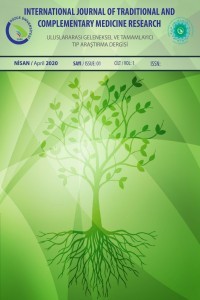
International Journal of Traditional and Complementary Medicine Research
Yazarlar: Mert DÖNMEZ, Şeref KARADENİZ, Taner YOLDAS, Gülşah AYDIN, Pınar KARAGÜL, Osman AKSU, Pınar GÖÇ RASGELE
Konular:Tamamlayıcı ve Entegre Tıp
Anahtar Kelimeler:Propolis Extraction,LC-MS/MS,GC/MS
Özet: Objective: Although the volatile components in the propolis composition are in very low concentration, they are extremely important for the characterization of propolis due to their aroma-giving properties and various biological activities. Since propolis is a product obtained from plants, its chemical composition depends on the local plant flora and the geographical and climatic characteristics of the region where the sample is collected. Therefore, different propolis samples can differ completely in terms of their chemistry and biological activities. Propolis extracts obtained by using different solvents have different contents. For this reason, the content of antioxidants varies, which causes differences in phenolic and flavonoid amounts. In the study, it was aimed to determine the efficacy of different propolis extracts produced as a result of beekeeping activities in Düzce province by comparing the chemical content. Material-Method: The extracts of propolis collected from Düzce province were prepared using ethanol, water and PEG400 – water solvents. In the study carried out, the volatile components of three different extracts of propolis samples obtained from hives belonging to Yığılca Region were examined with LC-MS/MS, GC-MS UV. The determination of the total phenolic component (TPC) level was carried out with the Folin-Ciocalteu reagent, and the total flavonoid content (TFC) level with the AlCl3 based method. Results: Major volatile constituents of Ethanolic extract; Diphenyl-1,2,5-oxadiazole (86.11%) and Benzenepropanoic acid ethyl ester (6.3%), Major volatile components of PEG400-water (50% - 50%) extract; 4-vinyl-2-methoxy-phenol (40.40%), Benzyl benzoate (17.16%), Methyl benzyl ketone (16.87%) ve Ethyl 3-methylnaphtho[1,2-c]pyrrole-1-carboxylate (14.32%), major volatile components of water extract; Benzyl Alcohol (79.91%) ve 4-vinyl-2-methoxy-phenol (8.86%). The highest TPC level was in ethanolic extract with 23,192.45 ± 396.54 mgGAE/100 g. Similarly, the highest TFC was found in ethanolic extract (7,190.12 ± 203.85 mgQE/100g). The water extract had the lowest levels at both TPC and TFC levels. Conclusion: It has been concluded that the highest phenolic content of propolis, which has recently begun to find an important use in the food and health sector, is obtained by ethanol extraction. When evaluated in terms of the obtained results from all methods, it is listed as Etanolic extract> PEG400> water extract. Further studies should be done using different solvents in order to extract as much of the components from propolis as possible.